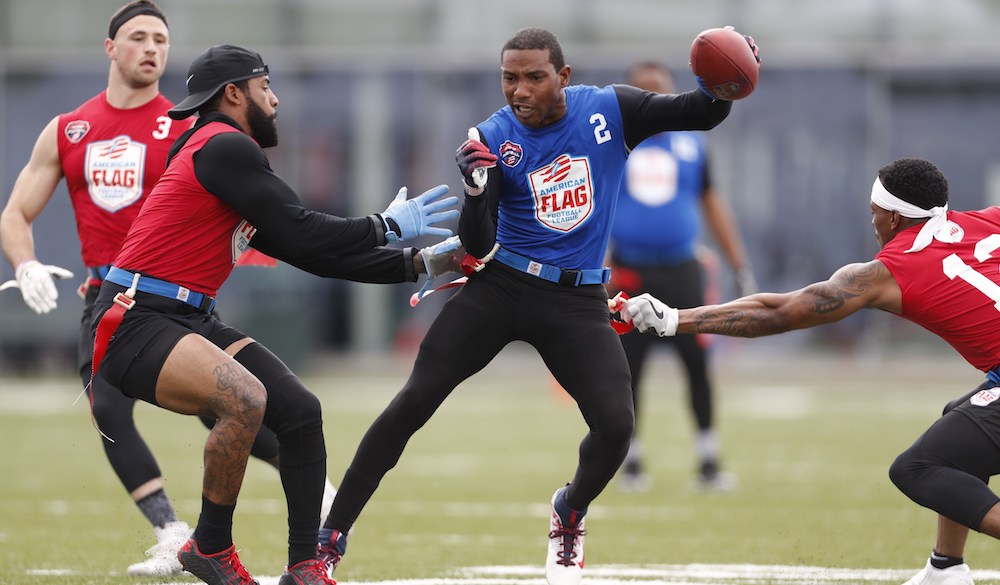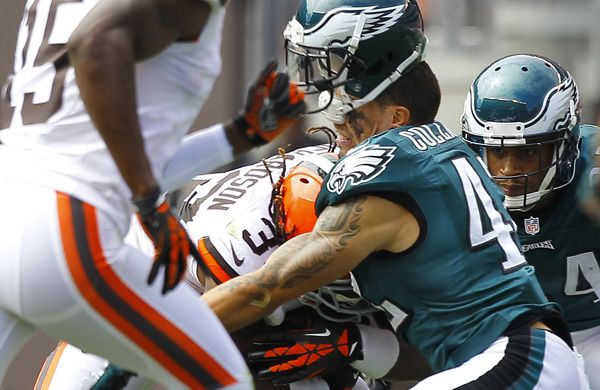Ask yourself for a moment, is tackle football really something the youth should be involved in? I know I probably sound like an old geezer tweeting vigorously about “the younger generation” when I say that, but seriously think about it for a moment. People talk about how the brain doesn’t stop developing until roughly the age of 25. Concussions are bad at any point in ones life, but before 25 when rapid cognitive development is occurring, large concussive impacts along with that development seem to be a recipe for disaster. Sure tackle football can teach great life lessons and foster lifelong relationships, but it can also leave those that play it in an altered mental state for the remainder of their lives. Ok, watch the video directly below and then we’ll talk again on the other side.
So… did your opinion change? What is an age that you would feel comfortable allowing your own children to start tackle football, if at all?
Is flag football a safer alternative?

Lets take a moment to look at some statistics before you judge flag football too harshly. Tackle football players age 6-14 sustained 15 times more head impacts than their flag football counterparts. Head impacts that were considered to be “hard hitting” occurred 25 times more frequently in tackle football than flag football. Essentially, in tackle football head impacts occurred far more frequently and with far greater force. These factors create more opportunity for concussions to occur in tackle football than in flag football. This inherently makes sense, it is the nature of flag football to mitigate collisions.
Ok, lets continue looking into the differences. Flag football players have a median of 8 head impacts per season while tackle football players experience a staggering 378 head impacts per season. These numbers alone should worry any parent who has a child involved in tackle football, think about that number for a second and consider the last time that you had a head impact let alone 378. I like football a lot, my brother and entire family played it, but I would be hesitant to put my future children in harms way. Even if the 378 head impacts are minor they can still compile on one another to create issues. My brother was a lineman in football, he would usually experience relatively few large hits but he would be hit nearly every play on the line for an entire game. The small hits he took throughout the game were so great in number that he sometimes had concussive like symptoms even though he never took a “big hit.” Look at the hit he delivers to the opponent in this play alone, this is not an anomaly is football, rather it is the norm. For reference he’s the big guy in blue in the middle that levels the orange player. Yes he delivered the hit in this situation to parts of the body other than the head, but there were plenty of times that the hits were in the direction of his head.
Video 2; via me
Youth football players can be as young as 5 years old. Think about that, if these same players get to play college ball they have played 13 years of football already. That means they’ve had 13 years to potentially suffer concussions. If they start at, oh lets say 10, then they have 8 years where they are compiling head impacts. Sure, kids will be kids and they will most likely receive injuries regardless of what we do to protect them, but allowing them to play tackle football is exacerbating the amount of those potential injuries.
The amount of head-to-head contact is directly responsible for the rates of concussions within youth athletes, eliminating that impact would alleviate the risk for concussions. As players get older they exert more force on one another and the subsequent rates of a concussion occurring increases. Because they exert more force on one another upon impact they are able to hurt one another in all new ways, not just via direct head-to-head impact. For example a player gets hit so hard that his head “whiplashes” and he gets a concussion. It is not longer the direct head contact that causes the injury but the force itself. The implementation of flag football as an alternative to highschool JV and Varsity football would help to alleviate the impacts on players brains. Sure, tackle football might be more fun to watch then flag football, that is all subjective and a personal opinion. However, one must ask the following; is risking player safety worth it when there seems to be an alternative. When players have a helmet on they feel invincible, the male football players in my school were completely indifferent to what they were doing to their bodies, in particular their brain. If tackle football removed equipment and still had contact it would essentially be rugby, which also has staggering rates of concussion due to high impact on the head. The implementation of flags allows for the alleviation of detrimental contact while still allowing for the beneficial nature of football (i.e. the life lessons, teamwork, and friendships that a sport creates). 
Historically speaking, money is football and football is contact. College football makes 4 billion dollars a year on only 65 of its teams, even more if you include the other hundreds of colleges involved in the many leagues. In the NFL, one franchise alone is worth 3.5 billion dollars on average. Tackle football certainly sells, and I’m actually not proposing we stop any of it. In fact I sit down every Sunday to watch the Vikings lose in spectacular fashion while simultaneously wishing I hadn’t. What I am proposing is that perhaps there needs to be some form of intervention that protects players before they join college teams. Players should be able to grasp and understand the negative side of football before their heads are at risk and they lose the capacity to do so. Eliminating years of potential concussion can benefit those that move on to future contact football, allowing them to start at an older age with a cleaner cognitive slate.
“Comparing Head Impacts in Youth Tackle and Flag Football.” Centers for Disease Control and Prevention. Centers for Disease Control and Prevention, May 19, 2021. https://www.cdc.gov/traumaticbraininjury/pubs/youth_football_head_impacts.html.